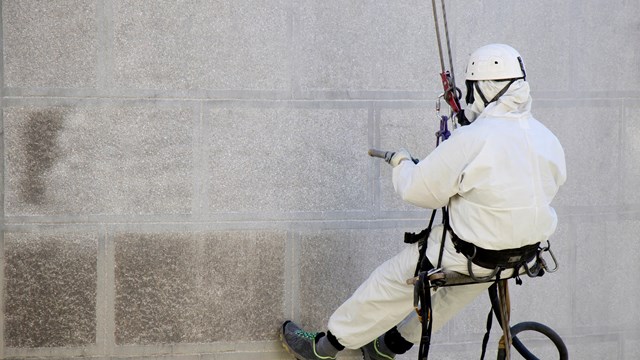The skyline of New York City is unique, if not for the soaring glass, steel, concrete and brick skyscrapers that create caverns in the sky, but for the redwood and cedar water tanks that sit on rooftops and hearken to days gone by.
A water tower, no matter the shape or size, and they vary, is simply a tall steel or wooden device designed to capture pressurized water. Most municipalities in the U.S. have them and some become landmarks or icons, i.e., the Chicago Water Tower—or the tank in Gaffney, South Carolina, that is in the shape of a peach or the one in Collinsville, Illinois that depicts a large-scale ketchup bottle.
The city’s conical-topped cylindrical towers, on the other hand, range from four to 26 feet in height and 10 to 20 feet in diameter, and provide city residents with the water they need for drinking, bathing, cooking and cleaning, and other everyday tasks. The tanks also provide the water supply needed by firefighters to fight any high-rise fires that may occur.
Water towers are elevated on steel platforms to supply the pressure needed to run major appliances and integral building systems. It is estimated that each foot of height is equivalent to approximately 0.43 PSI (pounds per square inch) of water pressure, according to Phil Kraus of Manhattan-based Fred Smith Heating and Plumbing.
All Pumped Up
According to the New York City Department of Environmental Protection (DEP), early Manhattan settlers obtained water for domestic purposes from shallow privately-owned wells. In 1677, the first public well was dug in front of the old fort at Bowling Green. In 1776, when the population reached approximately 22,000, a reservoir was constructed on the east side of Broadway between Pearl and White Streets. Water pumped from wells sunk near the Collect Pond, east of the reservoir, and from the pond itself, was distributed through hollow logs laid in the principal streets. In 1800, the Manhattan Company (now The Chase Manhattan Bank) sank a well at Reade and Centre Streets, pumped water into a reservoir on Chambers Street and distributed it through wooden mains to a portion of the community. In 1830, a tank for fire protection was constructed by the city at 13th Street and Broadway and was filled from a well. The water was distributed through 12-inch cast iron pipes. As the city’s population grew, so did the need for a safe, reliable water supply. The well water had became polluted and the supply was not sufficient.
After exploring alternatives for increasing supply, the city fathers decided to gather water from the Croton River, in what is now Westchester County, and to build an aqueduct to carry water from the Old Croton Reservoir. This aqueduct, known today as the Old Croton Aqueduct, had a capacity of about 90 million gallons per day and was placed in service in 1842. The distribution reservoirs were located in Manhattan at 42nd Street, where the New York Public Library now stands (discontinued in 1890) and in Central Park south of 86th Street (discontinued in 1925). New reservoirs were soon constructed to increase supply and the present water system was consolidated from the various water systems in communities throughout the boroughs of Manhattan, the Bronx, Brooklyn, Queens and Staten Island.
Today, according to the DEP, New York City has the largest unfiltered surface water supply in the world. Every day, some 1.3 billion gallons of water is delivered to eight million New York City residents, one million more consumers in four upstate counties and hundreds of thousands of commuters and tourists. The system includes a watershed of 1,969 square miles across eight counties north and west of the city. The system’s 19 reservoirs and three controlled lakes contain a total storage capacity of 580 billion gallons.
Approximately 95 percent of this total water supply is delivered to the residential and commercial populace by gravity—the remainder is pumped upwards to maintain the desired pressure.
“The city’s water is gravity-fed,” explains Andy Rosenwach, owner of the fourth generation Rosenwach Tank Co., in Long Island City. But, normal water pressure can only travel up about five or six stories, he says.
An Inside Job
Today, most of New York’s co-op and condo buildings use one of two systems to provide water and sanitation service to its residents. The city water originating from the street is pumped by gravity through risers in the building up to the rooftop tanks. From there, gravity feeds the water down to the units below.
By contrast, with a pressure tank system, the water comes in to the building and proceeds into pressure tanks located in the basement. Some older buildings in New York use both systems, while others only use one. Other buildings may use city water pressure for the first six floors, then switch to mechanical systems for the higher floors.
Water World
Rosenwach’s great-grandfather Harris purchased the company in 1896 for $55 and they have been building and maintaining rooftop tanks ever since. Rosenwach says that there are about 10,000 water tanks all told in New York City and his company still manufactures them out of redwood or western yellow cedar in their Brooklyn factory.
Basically, there are two types of tanks, the sprinkler water tank, which is only installed as a water reserve for the Fire Department, and the standpipe tank, which is used in most residential buildings today and is usually a combination tank that serves the building’s plumbing and is also used in case of a fire, according to Rosenwach. In the event of a fire, this water reserve wets down the exit and stairwells of the building.
Replacing a tank that provides domestic water to a building can be done rather quickly—in about 10 hours. Replacement of a sprinkler tank takes an average of about two days, Rosenwach says.
A traditional pump system in a rooftop water tank typically contains a rubberized float ball attached to a metal pole, and steel-encased high-voltage circuitry and mercury tube sensors which control the water level, the temperature, when the pump turns on or shuts off, and the security of the water supply, according to Rosenwach. In order to keep the potable water safe and clean, tanks must be inspected and cleaned annually to remove any collected sediment, he says.
“The roof tank provides a place where the sediment settles,” says Kraus. “You clean the roof tank once a year. And the sediment will settle at the bottom of the roof tank and won’t go down into the pipes, where if you have a booster pump, you’re sucking the water right off the street, and if there’s any sediment, it’s going right into your building.”
And, when it comes to repairs, “the advantage of the gravity system is simplicity. As long as you can get the water to the roof, gravity will do the rest,” adds Henri Billharz, vice president of Billharz Plumbing Inc., in Woodside. “In pressure tanks,” says Billharz, “bladders can break. Booster pumps can go out. Those pumps need to be greased and maintained regularly.”
Kraus agrees. Having a reservoir of water on the roof is desirable, just in case the city water is shut off for a time, or the booster pump in the basement breaks and repairs to the main line have to be made.
“You have this buffer, this cushion, you have this reservoir of water upstairs, which depending on the building could last between 6 to 12 hours or more. We’ve worked on a lot of different buildings and seen all the different problems, my own preference, I prefer having a roof tank system.”
The traditional float systems though are not maintenance-free either. Some of the issues inherent in a float system, Rosenwach says, is that the mercury tube may break from excessive cold or heat, and cause problems with its operation. Tanks tend to last on average between 30 to 35 years, (some last for decades) but the float switches require frequent replacement. They only have a lifespan of about 3 to 7 years, mainly due to wear-and-tear or possible malfunction.
Future World
The development of a more reliable switch brought Gatesoft Technology Corporation in San Jose, California, a technology and research and development firm, into the picture. Taking their cue from Rosenwach, who wanted a remote-controlled floatless switch, Joe Gentile, the company president, designed a computerized microprocessor panel that is pre-programmed just like a desktop computer to operate the circuitry and switches needed for the tank’s pump to operate.
The unit uses a single, non-moving mercury-free sensor on two low-voltage wires or cables that are then suspended inside the tank. The circuitry, which is embedded into a compact steel box, doesn’t need to be near or inside the tank but rather can be located in the pump room or in the basement of the building where it is monitored by a superintendent or on-site maintenance staff. Because of the micro-controller technology and mercury-free sensors, the floatless switch can send real time alerts to the super or building personnel, like a security guard or a doorman. In-house building staff can monitor the tank and pump system by personal computer or the information can be forwarded via the Internet to building workers in the field through a PDA or BlackBerry device, Gentile explains.
“We could have a remote panel at a doorman station, and the system will page you or send you an email alerting you to the fact there is a problem,” Gentile says.
High-Tech, Low Maintenance
There are also built-in redundant safety systems to prevent higher or lower than normal water levels, water overflowing the tank or interrupted power voltage, he says. Such problems would trigger an alarm that would shut down the malfunctioning pump and revert to the backup. Costs for the automatic switches in the floatless system range from an average of about $1,200 to $4,500 depending on the features and whether multiple switches would be required.
Contrary to popular opinion, wooden rooftop tanks are not a New York phenomenon, they exist in other cities like Chicago and Dallas, and other large urban centers. However, “Most people when they look up they think this archaic item is out of use. But they still perform a serviceable need,” says Rosenwach. “I think the tanks give a flavor to a city of glass, and stone, and masonry.”
In Paris, they have the Eiffel Tower, London has Big Ben, and Rome, the Coloseum and the Vatican. New York has its classic architecture, of course, but the wooden water towers that have framed the city’s classic skyline for the past 100 years, are widely celebrated for both their art and their function.
Debra A. Estock is the Managing Editor of The Cooperator.







Leave a Comment